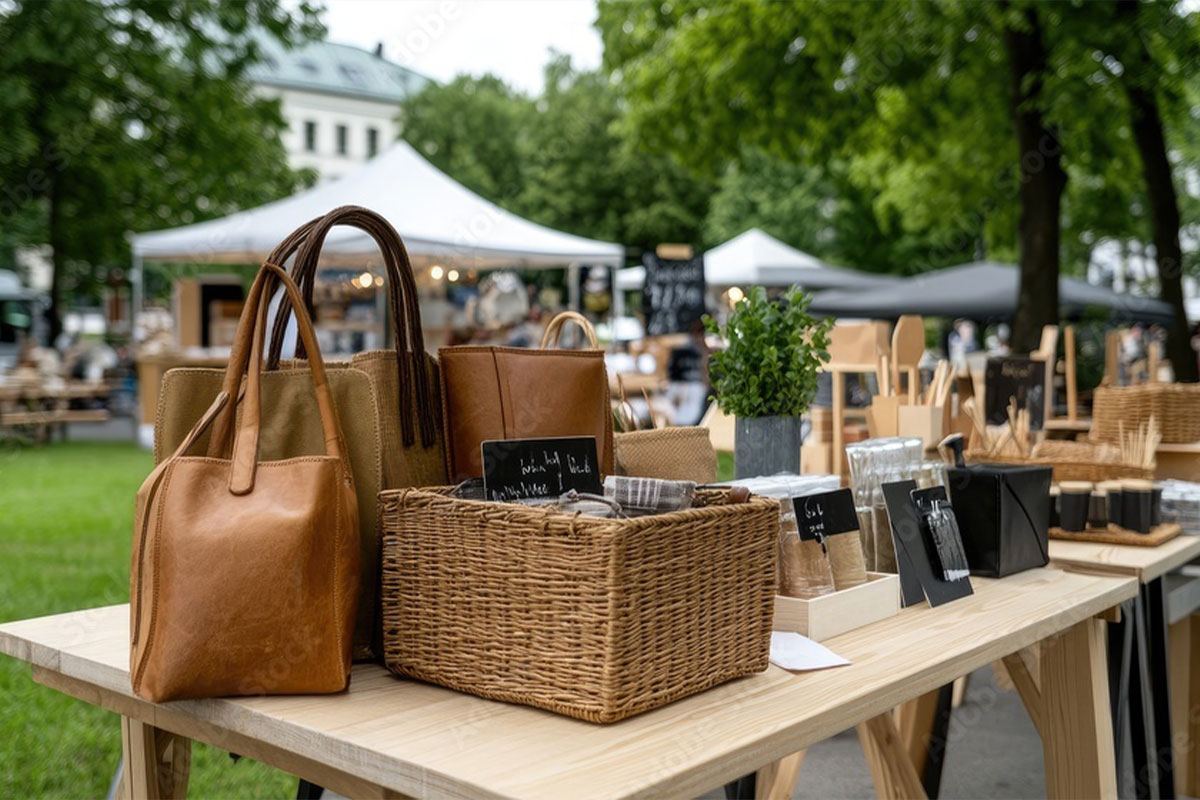You’ve found your dream home—congratulations! Moving can be an exciting new adventure, but there are a few more items to check off the to-do list before you can enjoy your new abode. One of the biggest tasks, of course, is packing up your belongings. While some items can be easily tossed in a box without fear of damage, other household goods are a bit trickier to transport. Heavy, fragile, valuable and oddly-shaped items require a bit more planning and care than other belongings, so it’s important to first understand the best ways to pack them.
To help you navigate this process, we’ve rounded up top tips from industry experts on how to pack 10 common, but tricky, household items.
General advice before we get started
- Before you begin packing anything, be sure to declutter. Sort through all of your belongings and determine what you’d like to keep, what you’d like to donate/give away and what can be tossed. That way, you’re not taking the time and effort to pack items you don’t need or want.
- Make sure you have sufficient supplies. This could include sturdy boxes, any specialty boxes, packing tape, newspaper and packing paper, bubble wrap, cardboard corner protectors, bags, scissors, permanent markers and more.
- Speaking of permanent markers, use them to stay organized by labeling each box with its contents, as well as adding “FRAGILE” and “THIS SIDE UP” where necessary.
- Set aside any essentials you’ll need immediately—think your toothbrush, chargers, a few changes of clothes and toilet paper. Pack these items separately, in a backpack or duffel bag, and make sure they’re easily accessible.
- Don’t forget to make the process enjoyable! Crank up some motivating tunes, get the whole family involved and make a game out of it!
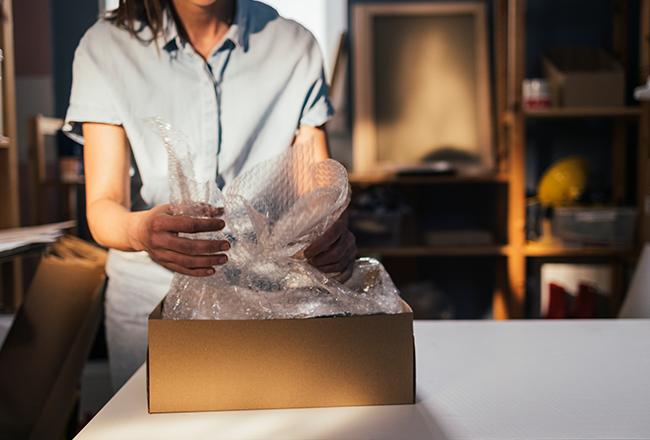
How to pack dishes for moving
Dishes—they’re necessary, but oh-so-breakable. These kitchen items can be intimidating to pack, but there are plenty of great suggestions out there for safely packaging and transporting plates, bowls, glasses and more from one place to another.
The key is to start with the heaviest dishes, which are usually large plates. First, pad the bottom of your cardboard box with packing paper. Wrap each plate individually with paper and use tape to secure them. Forbes suggests using packing paper over bubble wrap, because it’s “flexible, faster to use and creates protective air pockets around objects when crumpled.” Once you have four plates wrapped, stack them together and wrap them up as a group, taping the stack to keep it together. When placing the plates into the box, be sure to put them in vertically, like you would load a dishwasher. This helps prevent breakage from additional stress being placed on the plates.
Bowls should also be wrapped and taped with packing paper. They can be stacked on top of the plates or in their own box, but either way, lay them sideways in a single layer rather than nesting them inside each other. You can, however, stuff each bowl with extra paper for additional protection.
If you’re packing all of your dishes in the same box, glasses should go on top, as they are typically the lightest items. Wrap them with packing paper and, for wineglasses, be sure the paper molds snugly around the stem. Cups and glasses should be packed in a single layer on their sides, rather than nested. Cell boxes with individual slots are also great options for packing cups and glasses. Don’t forget to stuff extra packing paper into the empty spaces between dishes, so they don’t move around in transit.
How to pack books for moving
Before packing up your book collection, take the time to thin it out sufficiently. School libraries, used bookstores and second-hand shops are great places to donate any books you no longer need.
For hardcover books, you can either lay them flat or stand them upright (like on a bookshelf) with their spines against the box. Lighter books, like paperbacks, can be laid flat and stacked on top of each other, or you can also alternate the stacking and upright methods to conserve space. If you have valuable or delicate volumes, The Spruce suggests wrapping each book in packing paper and stacking them, laying a piece of cardboard between each one for extra protection. Pack these books in a separate box from your others.
Pro tip: Books are some of the heaviest items to pack, so be sure not to overfill your boxes and use caution when picking them up.
How to pack shoes for moving
The simplest method for packing shoes would be to use the original boxes they came in, but we know many people don’t have the space to hang onto all of their shoe boxes. Luckily, there are several other ways to effectively move your footwear.
Before you begin, take the time to sort your shoes by categories—boots, sneakers, heels and sandals, for instance. It’s also a good idea to keep pairs together, either by tying laces together or keeping individual pairs in smaller bags, as recommended by Nike. Stuff shoes like boots and sneakers with newspaper or packing paper, so they retain their shape.
A hanging shoe rack or a traditional box are both effective ways to move your shoes. If you’re using a box, stack the bulkiest shoes at the bottom, then layer according to weight. Sandals should go at the top. When packing heels, Apartment Therapy says, “you can layer in towels or sweatshirts to ensure the heels don’t scuff each other.” You may also want to add some sheets of bubble wrap or packing paper between each layer of shoes.
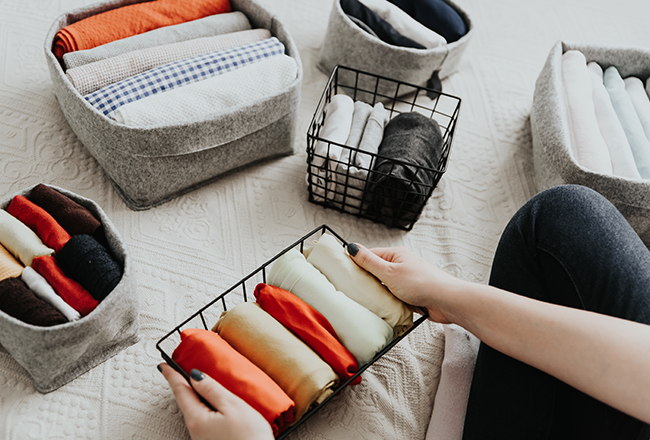
How to pack clothing for moving
As with shoes, it’s recommended that you first sort your clothing by type. This will make it easier to pack similar items using the same method, as well as simplify your unpacking process.
For non-hanging clothes, folding and rolling are two common methods. Fold items such as pants and sweaters into flat squares and roll up T-shirts and similar clothing pieces. Line the bottom of a cardboard box with packing paper (to help prevent clothing from getting wet or dirty) and stack your clothing in single layers, keeping similar items together. Vacuumed-sealed bags are well-suited for bulkier items such as heavy coats.
Architectural Digest suggests using wardrobe boxes, rolling racks or garment bags to transport any hanging clothing. Garment bags are especially useful for delicate items, although you can also wrap these items individually in tissue paper and pack them in a separate box labeled FRAGILE. If you don’t have a garment bag, a large garbage bag is an acceptable substitute. “Simply slip large, drawstring trash bags under and over your hanging clothes while they are still in the closet. Cinch the drawstring around the hangers and tie it securely,” says Home Depot.
How to pack jewelry for moving
There are several challenges you may encounter when moving jewelry—small pieces could get lost, necklaces may tangle and delicate pieces could be damaged—which is why it’s important to pack your jewelry with great care.
To prevent tangling, be sure to pack necklaces individually. You can either place them in small pouches or, for a more DIY method, you can thread necklaces through straws or toilet paper/paper towel rolls and clasp the ends together. Bracelets can also be kept in small pouches or bags. Once each item is individually packaged, place them all in a larger bag or plastic bin.
Because they’re small and come in pairs, earrings can also be tricky. The Martha Stewart blog offers the helpful tip of piercing earrings through a piece of foam, then securing the backs with a small piece of tape. Wrap the foam in multiple sheets of packing paper and tape it up before placing it in a box. Pill organizers can also be a handy tool for packing small items such as earrings or rings.
Sterling Forever, an online jeweler, recommends making note of any missing or broken pieces before you start packing. This can help you identify if any jewelry was damaged or lost during the move. The jeweler also mentions that jewelry boxes with multiple compartments are helpful for securing and transporting pieces of varying shapes and sizes
How to pack a TV for moving
Before you begin, take photos of how any cables and wires are connected to your TV, so you know how to reassemble them in your new home. You’ll also want to place the cables, wires and any other accessories in storage bags and label them accordingly.
If you have the original box your TV came in, that would be the best method for packing. However, if you didn’t hang onto the box, many packing supply stores carry cardboard boxes that will fit flat screen TVs. If you own a bulkier television, you may need to use bubble wrap and moving blankets instead.
When using a box, you’ll first wrap the TV with several layers of bubble wrap to protect the screen. Secure the wrap with packing tape, but don’t let the tape touch the screen itself. If you have the original box and packing materials, you can use the protective sleeve your TV came in instead.
If your TV is too bulky to fit in a box, Home Depot suggests this method: wrap the TV in two to three layers of bubble wrap and secure with tape. Pad any corners with a piece of foam or cardboard, then spread a blanket out and place the TV in the center with the screen-side facing up. Fold the blanket over on each side, secure with tape and wrap the entire bundle with stretch wrap.
When loading your TV into the moving vehicle, set it upright and fill the empty space around the television with other boxes or blankets to prevent it from moving around.
How to pack lamps for moving
Lamp bases, shades and light bulbs should always be packed separately. The bulbs, once they’re removed, can be wrapped in small pieces of bubble wrap and placed in a cell box. Shades should be wrapped with packing paper and secured with tape, then placed in a box lined with paper. If they’ll fit comfortably, you can stack smaller shades inside of larger ones, according to House Digest, but don’t put anything except paper or bubble wrap on top of the lampshades.
For lamp bases, you’ll first want to wrap the cord around it and tuck the plug into the cord. If you are packing a table lamp, roll the base up in bubble wrap, tape it and lay it down at the bottom of your box. You can pack multiple bases in the same box if they’ll fit comfortably—just be sure to fill the extra space with bubble wrap or paper. Floor lamps will also need to be wrapped in bubble wrap, but they should be packed individually and will require taller boxes.
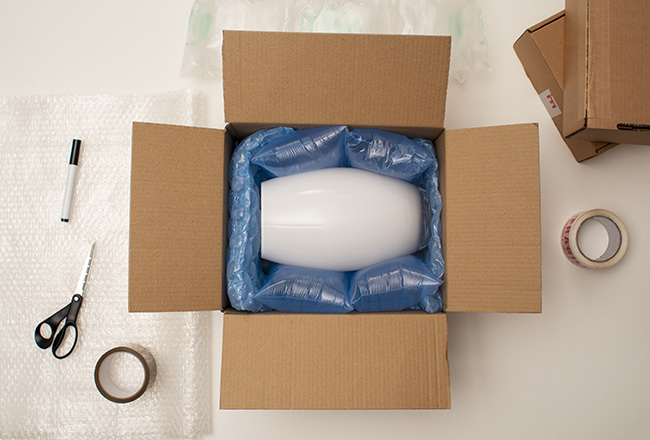
How to pack artwork for moving
The process for moving artwork all depends on the type of piece. Posters, for instance, are fairly simple: lay the poster image-side up and roll it from one end to the other. Tape the seam, then slide the item into a poster tube.
Framed or canvas artwork, however, is a bit trickier. For framed pieces with a layer of glass, you’ll first want to tape an X over the glass with masking tape. This keeps the glass from moving around too much and helps prevent shattering. Art without glass, such as canvas paintings, should be wrapped in several layers of plastic or palette wrap. The Spruce cautions against using newspaper, though, since the ink could bleed onto the art.
Framed and unframed art can then be placed face-down on a layer of packing paper and wrapped up. Secure the paper with sufficient tape and repeat the process with bubble wrap. Cardboard corner protectors are great for keeping the edges safe. When setting the art in its box, stand it up on its side rather than laying it down flat, and fill any extra space with paper.
If you’re moving sculptures or any other oddly shaped art pieces, Today’s Homeowner offers helpful advice on packing them. You should “wrap the entire sculpture in plastic wrap, taking care to place plastic tightly into all nooks and crannies in the sculpture.” Use bubble wrap to add extra protection to any weak points or protrusions, then cover the whole sculpture with bubble wrap until it looks like “a ball or egg.” Place the sculpture in a box and stuff empty space with more paper.
Pro tip: To avoid smudges, stains or fingerprints, wear gloves while packing artwork.
How to pack mirrors for moving
Just as with your television, the easiest way to pack a mirror is to use the box it came in, but there are also mirror-specific boxes available from packaging suppliers.
You’ll first lay your mirror face up and use the same taping method you used for your framed artwork. In addition to taping a large X, you’ll also tape a grid over the glass to help prevent shattering. For rectangular or square mirrors, cardboard protectors are recommended. Angi (formerly Angie’s List) suggests cutting two pieces of cardboard and taping them to the front and back of your mirror for added protection. Then, wrap the mirror in a layer of packing paper and a layer of bubble wrap, securing both with tape. Pad the bottom of your box with packing paper and slide the mirror inside, filling in any gaps with more paper.
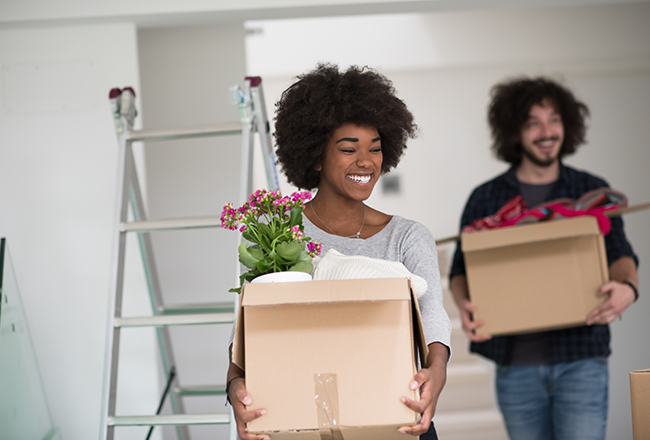
How to pack plants for moving
Any plant parents out there likely understand how difficult it can be to transport them, especially since plants are living things that come in all shapes and sizes.
An article from Forbes lays out several handy tips for successfully moving your plant collection. First, you may want to transfer plants in heavy pots to lighter plastic containers, so you can wrap the heavy pots up separately and prevent breakage. The pots can be wrapped in layers of packing paper and bubble wrap, while the plants in their plastic containers can be placed in a plastic bag and secured with a piece of string or a loose rubber band. “The bag should fit snugly around the pot, with any slack taken up, and the opening should be secure but not overly tight,” says Forbes. The plastic bag helps prevent soil from spilling out if the plant is somehow knocked over.
When boxing up your plants, you can either keep the box open or cut holes in the sides to ensure proper airflow and prevent the plants from overheating. Pack your plants in a single, snug layer and fill extra space with paper to prevent them from moving around. Smaller plants will also do well in a cell box. Consider wrapping pointy plants, like cacti, in an extra layer of bubble wrap.
Pro tip: Architectural Digest advises readers to keep their plants out of direct sunlight while transporting them.
So, there you have it! Packing can be an involved process, but it’s well worth it when all of your possessions arrive at your new home in one piece. We hope this collection of expert advice helps make the task a little easier!
For additional resources to guide you through your move, take a look at these Homeward™ articles:
- Your Printable Moving Checklist
- Preparing For A Move: How To Declutter & Minimize
- How To Choose A Moving Company (some even offer packing services, if DIY seems too daunting)
- Where to Donate Household Items
Be the first to hear about special offers!
Stay up to date on new neighborhoods and floor plans, special offers and more. Sign up for local email alerts.
Sources:
- https://www.forbes.com/home-improvement/moving-services/how-to-pack-glasses-dishes/
- https://www.thespruce.com/pack-and-move-books-2436599
- https://www.nike.com/a/how-to-pack-shoes
- https://www.apartmenttherapy.com/how-to-pack-shoes-37096937
- https://www.architecturaldigest.com/reviews/moving/how-to-pack-clothes-for-moving
- https://www.homedepot.com/c/ah/how-to-pack-clothes-for-moving/9ba683603be9fa5395fab9018b736650
- https://www.marthastewart.com/1530564/how-to-pack-jewelry-for-a-move
- https://www.sterlingforever.com/blogs/blog/how-to-pack-jewelry-for-moving
- https://www.homedepot.com/c/ah/how-to-pack-a-tv-for-moving/9ba683603be9fa5395fab901ef628824
- https://www.housedigest.com/1108874/how-to-carefully-prepare-and-pack-your-lamps-for-moving-day/
- https://www.thespruce.com/moving-and-packing-artwork-2436483
- https://todayshomeowner.com/moving/guides/complete-guide-to-packing-artwork-for-moving/
- https://www.angi.com/articles/how-pack-mirror-moving.htm
- https://www.forbes.com/home-improvement/moving-services/how-to-pack-houseplants-for-a-move/
- https://www.architecturaldigest.com/story/how-to-move-plants





